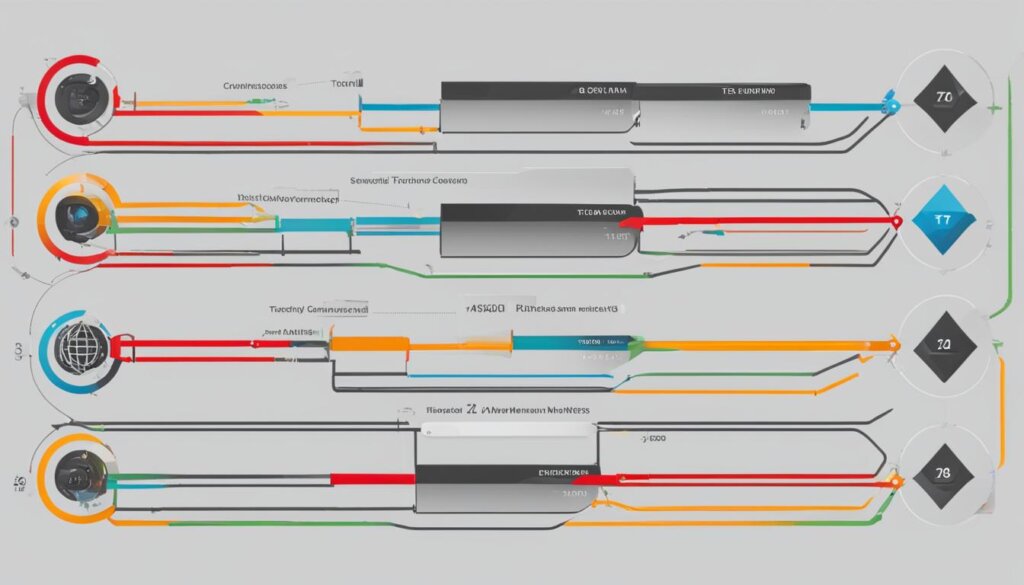Table of Contents
Time-to-live (TTL) is a value that determines the lifespan of a packet or data in a computer or network before it is discarded. In the context of networking, TTL serves as a counter or timestamp embedded in each packet. It prevents data packets from circulating indefinitely and manages data caching, boosting performance.
Administrators can set TTL to any value between 1 and 255. When a packet reaches a router, the router subtracts 1 from the TTL count and discards the packet when the count reaches 0. TTL is also used in pinging to determine the route to a host and in DNS to manage cache expiration.
Understanding how TTL works is essential for efficient data transmission and network management.
TTL in Networking and Multiprotocol Label Switching
TTL (Time-to-live) serves a critical function in networking by preventing data packets from circulating indefinitely. When packets remain in the network for too long, they can create routing loops and congestion, impacting overall network performance. TTL ensures that packets are discarded after a certain period, maintaining the integrity of the network.
In Multiprotocol Label Switching (MPLS) networks, the TTL value is essential for efficient packet delivery. When a packet enters an MPLS cloud, the TTL value is copied from the IP TTL. This value is then copied back to the IP TTL when the packet leaves the cloud. This process ensures that the TTL value is preserved and maintains the efficiency of packet delivery within MPLS networks.
By implementing TTL in networking and MPLS, organizations can enhance network performance, reduce congestion, and prevent routing issues. The proper management of TTL values is crucial for maintaining an efficient and reliable network infrastructure.
| TTL in Networking and MPLS Benefits | Explanation |
|---|---|
| Prevention of Routing Loops | TTL ensures that packets are discarded when they have been in the network for too long, preventing routing loops and potential network disruptions. |
| Efficient Packet Delivery | The copying of the TTL value in MPLS networks helps maintain the integrity of the TTL value and ensures the efficient delivery of packets across the network. |
| Reduced Network Congestion | By discarding packets with expired TTL values, TTL helps prevent congestion in the network and ensures optimal performance. |
In summary, TTL in networking and Multiprotocol Label Switching is vital for maintaining network performance and preventing packet congestion. By implementing and managing TTL values effectively, organizations can optimize their network infrastructure and ensure efficient packet delivery.
TTL in DNS and HTTP
TTL (Time-to-Live) is not only critical in networking but also plays a significant role in the Domain Name System (DNS) and Hypertext Transfer Protocol (HTTP). It helps manage cache expiration, DNS record propagation, and efficient delivery of web content. Understanding TTL in DNS and HTTP is key to optimizing performance and user experience.
TTL in DNS
In DNS, TTL sets the expiration time of DNS records in cache. It determines how long a cache server can provide its cached value for a record before reaching out to the authoritative server for an updated value. Shorter TTL values ensure that changes in DNS records propagate quickly across the internet, allowing for efficient and timely updates.

By setting appropriate TTL values for DNS caching, administrators can ensure that changes in domain configurations, such as IP address updates or domain name changes, are reflected accurately and propagated efficiently across the DNS infrastructure. This helps maintain the integrity and up-to-dateness of DNS records.
TTL in HTTP
TTL also plays a crucial role in HTTP caching, which is essential for delivering web content efficiently. In HTTP, TTL determines how long cached web content can be served before the web server checks for fresher content. By setting an appropriate TTL value, website administrators can balance the performance benefits of serving cached content with the need to deliver fresh and updated information to users.
When the TTL of cached content expires, the web server checks for updates and serves the freshest version if available. This ensures that users receive the most recent and relevant information, reducing the risk of outdated or incorrect content being served.
Caching in HTTP improves website load times and reduces server load by serving cached content instead of generating it dynamically for every user request. Setting an optimal TTL value helps strike the right balance between performance and content freshness.
To summarize, TTL in DNS and HTTP is vital for managing cache expiration, DNS record propagation, and efficient delivery of web content. By setting appropriate TTL values, organizations can optimize performance, ensure accurate DNS record updates, and provide users with up-to-date web content.
TTL in Transistor-Transistor Logic (TTL)
Transistor-Transistor Logic (TTL) is a family of digital logic design that utilises bipolar junction transistors to process direct-current pulses. TTL gates are constructed using transistors, resistors, and diodes, serving as fundamental logical structures in digital circuits.
One of the key features of TTL gates is their various characteristics, including fan-in, fan-out, power dissipation, propagation delay, and noise margin. These characteristics determine the gate’s performance and suitability for specific applications in logic design.
Within the TTL family, there are different types tailored to different requirements. These types include standard TTL, fast TTL, low-power TTL, low-voltage TTL, Schottky TTL, low-power Schottky TTL, open-collector TTL, and tri-state TTL. Each type possesses distinct characteristics and applications, aiding designers in selecting the most appropriate TTL technology for their electronic devices.
Although TTL technology has been largely superseded by other integrated circuit (IC) technologies, the underlying logic gates inherent in TTL remain vital in modern electronic devices, providing the foundational building blocks for efficient and reliable digital circuitry.
FAQ
What does TTL stand for and what is its meaning?
TTL stands for Time-to-Live. In the context of computer networking, TTL is a value that determines the lifespan of a packet or data before it is discarded. It serves as a counter or timestamp embedded in each packet and prevents data packets from circulating indefinitely.
How does TTL work in networking?
When a packet reaches a router, the router subtracts 1 from the TTL count and discards the packet when the count reaches 0. This prevents routing loops and congestion in the network, ensuring efficient data transmission.
What is the significance of TTL in networking?
TTL plays a vital role in preventing packet congestion and maintaining network performance. It ensures that packets are discarded when they have been in the network too long, preventing them from circulating indefinitely.
How does TTL work in Multiprotocol Label Switching (MPLS) networks?
In MPLS clouds, the TTL value is copied from the IP TTL when the packet enters the cloud and copied back to the IP TTL when it leaves. This helps maintain the integrity of the TTL value and ensures efficient packet delivery within MPLS networks.
What is the importance of TTL in the Domain Name System (DNS) and Hypertext Transfer Protocol (HTTP)?
In DNS, TTL is used to define the expiration time of DNS records in cache. It determines how long a cache server can provide its cached value for a record before reaching out to the authoritative server for an updated value. In HTTP, TTL determines how long cached web content can be served before the web server checks for fresher content.
How does TTL affect caching in DNS and HTTP?
Shorter TTL values in DNS ensure that changes in DNS records propagate quickly across the internet. Setting appropriate TTL values for DNS and HTTP caching helps ensure efficient and up-to-date delivery of information to users.
What is Transistor-Transistor Logic (TTL) and its role in logic design?
Transistor-Transistor Logic (TTL) is a family of digital logic design that uses bipolar junction transistors to process direct-current pulses. TTL gates, built using transistors, resistors, and diodes, provide essential logical constructs for digital circuits.
What are the characteristics of TTL gates?
TTL gates have characteristics such as fan-in, fan-out, power dissipation, propagation delay, and noise margin. These characteristics determine the performance and reliability of TTL gates in digital circuits.
What are the different types of TTL?
There are different types of TTL, including standard TTL, fast TTL, low-power TTL, low-voltage TTL, Schottky TTL, low-power Schottky TTL, open-collector TTL, and tri-state TTL. Each type has specific characteristics and applications in digital logic design.













